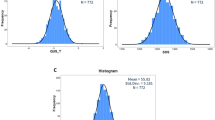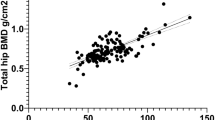Abstract
Identifying women with osteoporosis remains a clinical challenge, as it may not be feasible or cost-effective to recommend dual-energy X-ray absorptiometry (DXA) for all postmenopausal women. In this regard, quantitative ultrasound (QUS) has emerged as an attractive screening tool because of the (relatively) low cost and because QUS and DXA-assessed BMD appear to be equally predictive of future (hip) fracture risk. The objective of this study was to compare the ability of calcaneal QUS to identify osteoporosis with two alternative potential screening methods: digital X-ray radiogrammetry (DXR) and radiographic absorptiometry (RA). We enrolled a total of 221 postmenopausal community-dwelling Caucasian women aged 50–75 years. Bone mineral density (BMD) was measured at the lumbar spine and the total hip regions using DXA. Calcaneal ultrasound attenuation and velocity were assessed using QUS and metacarpal and phalangeal bone density were estimated by the use of DXR and RA, respectively. Receiver operating characteristic (ROC) curves were constructed by calculating the specificity and sensitivity of QUS, DXR, and RA at different cut-point values in discriminating osteoporosis, as defined by a T-score below –2.5 at the spine or hip using DXA, and the areas under the curves (AUCs) were computed. The sensitivity for identifying women with osteoporosis was 67.6% [95% confidence interval (CI), 50.2–82.0%] using QUS and was 76.9% (95% CI, 60.7–88.8%) and 82.9% (95% CI, 67.9–92.8%), respectively, using DXR and RA. The negative predictive value (NPV, the proportion of patients with a negative test who have no osteoporosis) was 90% for QUS, compared with an NPV of 94% for both DXR and RA. These data suggest that metacarpal DXR and phalangeal RA may be as effective as calcaneal QUS for targeting DXA testing in high-risk postmenopausal women.




Similar content being viewed by others
Refererences
Grampp S, Genant HK, Mathur A, Lang P, Jergas M (1997) Comparisons of non-invasive bone mineral measurements in assessing age related loss, fracture discrimination and diagnosis classification. J Bone Miner Res 12:697–711
Kanis J for the WHO study group (1994) Assessment of fracture risk and its application to screening for postmenopausal osteoporosis: synopsis of a WHO report. Osteoporos Int 4:368–381
Cummings SR, Black DM, Nevitt MC, Browner W, Cauley J, Ensrud K, Genant H, Hulley S, Palermo L, Scott J, Vogt T (1993) Bone density at various sites for prediction of hip fractures. Lancet 341:72–75
Lydick E, Cook K, Turpin J, Melton M, Stine R, Byrnes C (1998) Development and validation of a simple questionnaire to facilitate identification of women likely to have low bone density. Am J Manag Care 4:37–48
Von Mühlen D, Visby Lunde A, Barrett-Connor E, Betencourt R (1999) Evaluation of the Simple Calculated Osteoporosis Risk Estimation (SCORE) in older Caucasian women: the Rancho Bernardo Study. Osteoporos Int 10:79–84
Genant HK, Engelke K, Fuerst T (1996) Noninvasive assessment of bone mineral and structure: state of the art. J Bone Miner Res 11:707–730
Rosholm A, Hyldstrup L, Baeksgaard L, Grunkin M, Thodberg H (2001) Estimation of bone mineral density by digital X-ray radiogrammetry: theoretical background and clinical testing. Osteoporos Int 12:961–969
Mussolino ME, Looker AC, Madans JH, Edelstein D, Walker RE, Lydick E, Epstein RS, Yates AJ (1997) Phalangeal bone density and hip fracture risk. Arch Int Med 157:433–438
Boonen S, Kaufman JM, Réginster JY, Devogelaer JP (2003) Patient assessment using standardized bone mineral density values and a national reference data base. Osteoporos Int 14:110–115
Hans D, Dargent-Molina P, Schott A (1996) Ultrasonographic heel measurements to predict hip fracture in the elderly. Lancet 348:511–514
Bauer D, Glüer C, Cauley J (1997) Bone ultrasound predicts fractures strongly and independently of densitometry in older women: a prospective study. Arch Int Med 157:629–634
Glüer C, Wu C, Jergas M, Goldstein S, Genant H (1994) Three quantitative ultrasound parameters reflect bone structure. Calcif Tissue Int 55:46–52
Cummings S, Black D, Thompson D, Applegate W, Barrett-Connor E, Musliner T, Palermo L, Prinea R, Rubin S, Scott J, Vogt T, Wallace R, Yates J, LaCroix A (1998) Effect of alendronate on risk of fracture in women with low bone density but without vertebral fractures: results from the Fracture Intervention Trial. JAMA 280:2077–2082
Black D, Cummings S, Karpf D, Cauley J, Thompson D, Nevitt M, Bauer D, Genant H, Haskell W, Marcus R, Ott S, Torner J, Quandt S, Reiss T, Ensrud K (1996) Randomized trial of effect of alendronate on risk of fracture in women with existing vertebral fractures. Lancet 348:1535–1541
Ettinger B, Black D, Mitlak B, Knickerbocker R, Nickelsen T, Genant H, Christiansen C, Delmas P, Zanchetta J, Stakkestad J, Glüer C, Krueger K, Cohen F, Eckert S, Ensrud K, Avioloi L, Lips P, Cummings S (1999) Reduction of vertebral fracture risk in postmenopausal women with osteoporosis treated with raloxifene. JAMA 282:637–645
Réginster JY, Minne H, Sorensen O, Hooper M, Roux C, Brandi M, Lund B, Ethgen D, Pack S, Roumagnac I, Eastell R (2000) Randomized trial of the effects of risedronate on vertebral fractures in women with established postmenopausal osteoporosis. Osteoporos Int 11:83–91
Kanis J, Glüer C for the Committee of Scientific Advisors of the IOF (2000) An update on the diagnosis and assessment of osteoporosis with densitometry. Osteoporos Int 11:192–202
National Osteoporosis Foundation (1999) Physician’s guide to prevention and treatment of osteoporosis. Excerpta Medica, Belle Mead, N.J.
Hanley J, McNeil B (1982) The meaning and use of the area under a receiver operating characteristic curve. Radiology 143:29–36
Cadarette S, Jaglal S, Murray T, McIsaac W, Joseph L, Brown J for the Canadian Multicentre Osteoporois Study (2001) Evaluation of decision rules for referring women for bone densitometry by dual-energy X-ray absorptiometry. JAMA 286:57–63
Faulkner K, McClung M, Coleman L (1994) Quantitative ultrasound of the heel: correlation with densitometric measurements at different skeletal sites. Osteoporos Int 4:42–47
Herd R, Blake G, Miller C (1994) The ultrasonic assessment of osteopenia as defined by dual X-ray absorptiometry. Br J Radiol 67:631–635
Young H, Howey S, Purdie D (1993) Broadband ultrasound attenuation compared with dual-energy X-ray absorptiometry in screening for postmenopausal low bone density. Osteoporos Int 3:160–164
Benitez C, Schneider D, Barrett-Connor E, Sartoris D (2000) Hand ultrasound for osteoporosis screening in postmenopausal women. Osteoporos Int 11:203–210
Glüer C and the International Quantitative Ultrasound Consensus Group (1997) Quantitative ultrasound techniques for the assessment of osteoporosis: expert agreement on current status. J Bone Miner Res 12:1280–1288
Greenspan S, Maitland-Ramsey L, Myers E (1998) Classification of osteoporosis in the elderly is dependent on site-specific analysis. Calcif Tissue Int 58:409–414
Eddy DM, Johnston CC, Cummings SR, Dawson-Hughes B, Lindsay R, Melton LJ, Slemenda CW (1998) Osteoporosis: review of the evidence for prevention, diagnosis, and treatment and cost-effectiveness analysis. Osteoporos Int 8:S1–S88
Looker A, Wahner H, Dunn W (1995) Proximal femur bone mineral levels of US adults. Osteoporos Int 5:389–409
Acknowledgements
Dr. S. Boonen and J. Nijs contributed equally to the manuscript. Dr. S. Boonen is the holder of the Leuven University Chair in Metabolic Bone Diseases, founded and supported by Merck Sharp & Dohme. Dr. S. Boonen and Dr. D. Vanderschueren are senior clinical investigators of the Fund for Scientific Research-Flanders, Belgium (F.W.O.-Vlaanderen). The authors wish to thank J. Cartois and H. Vanderstraeten for excellent editorial assistance. This study was supported by Agfa Gevaert NV, Mortsel, Belgium.
Author information
Authors and Affiliations
Corresponding author
Rights and permissions
About this article
Cite this article
Boonen, S., Nijs, J., Borghs, H. et al. Identifying postmenopausal women with osteoporosis by calcaneal ultrasound, metacarpal digital X-ray radiogrammetry and phalangeal radiographic absorptiometry: a comparative study. Osteoporos Int 16, 93–100 (2005). https://doi.org/10.1007/s00198-004-1660-z
Received:
Accepted:
Published:
Issue Date:
DOI: https://doi.org/10.1007/s00198-004-1660-z




